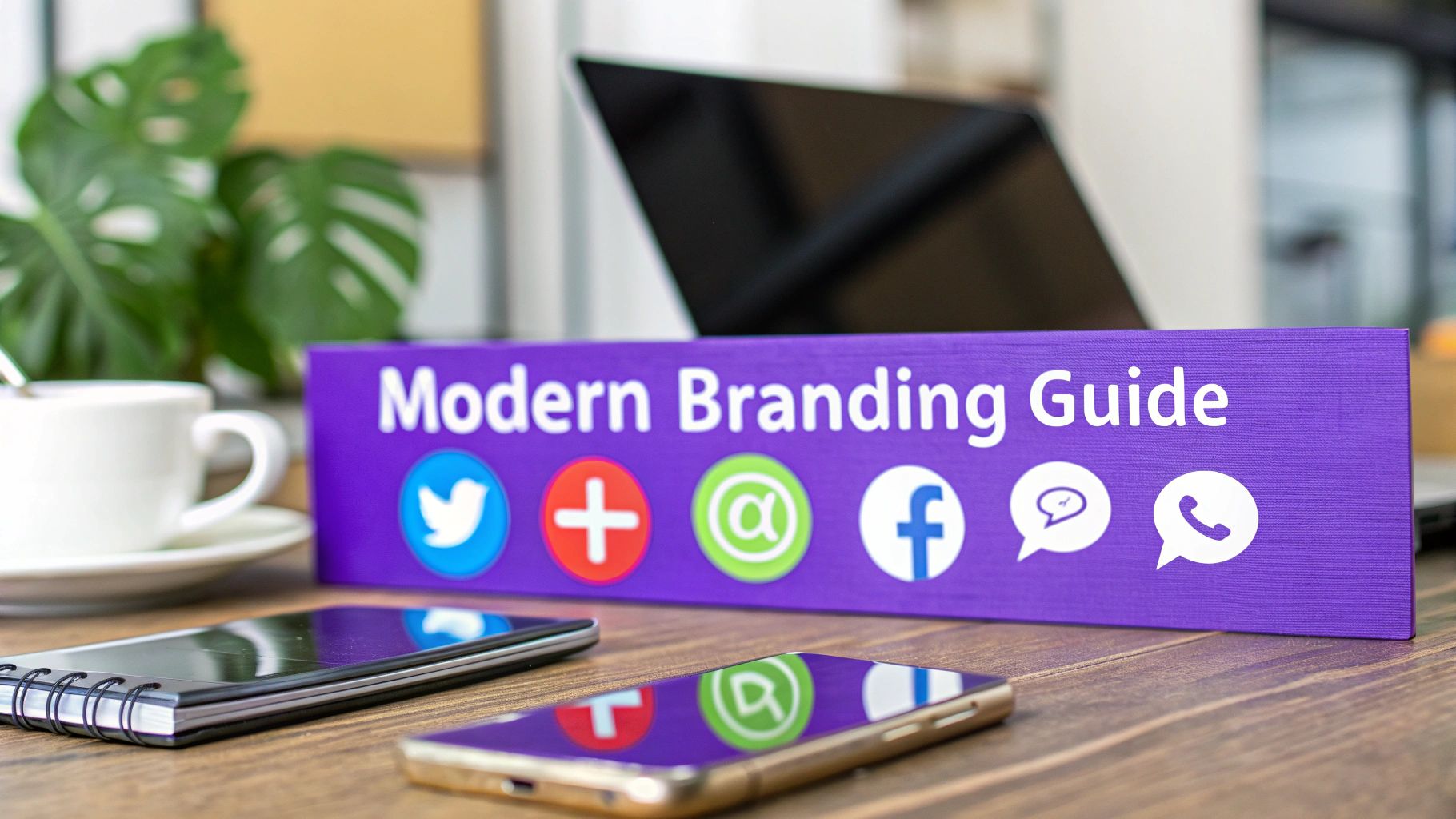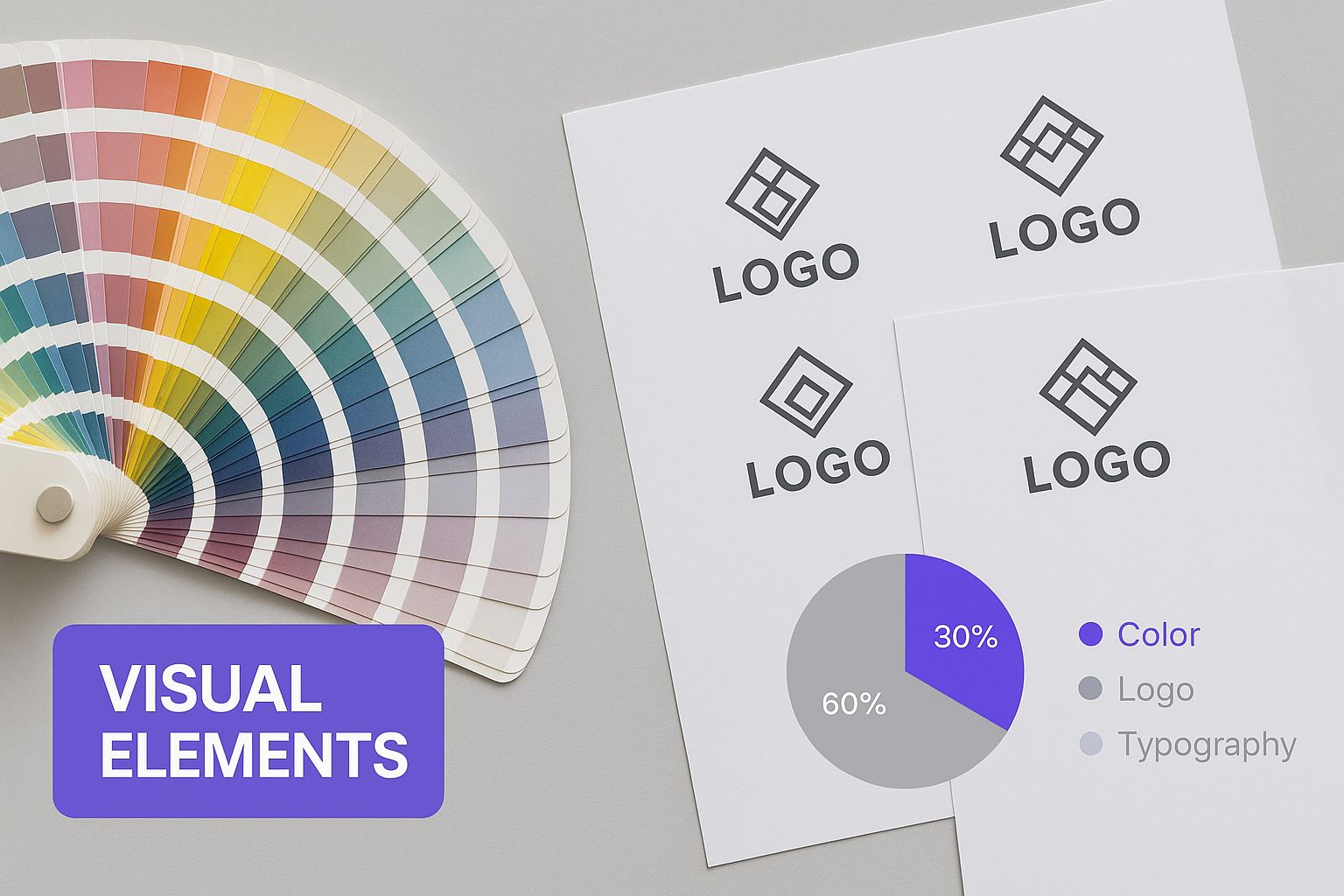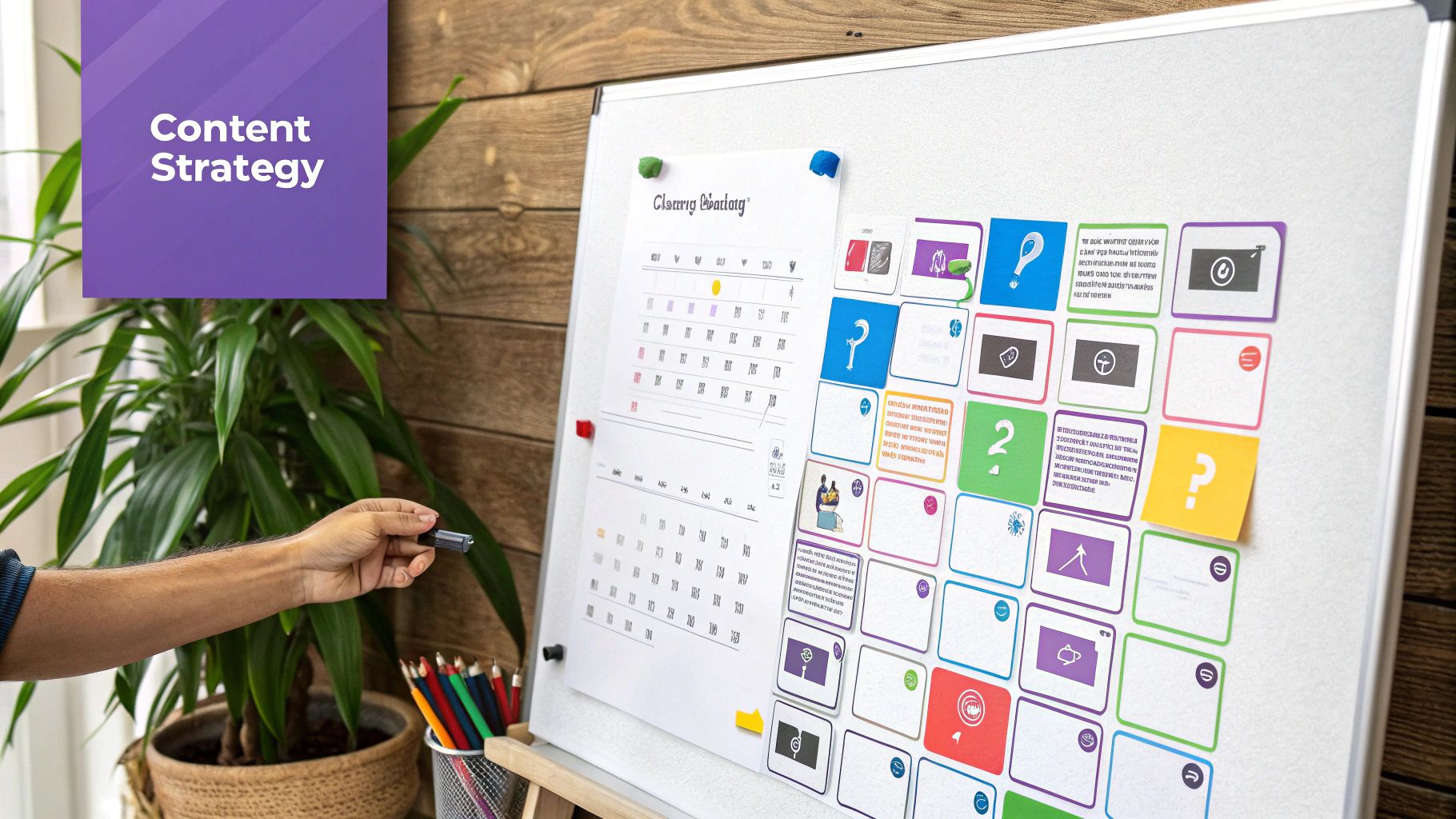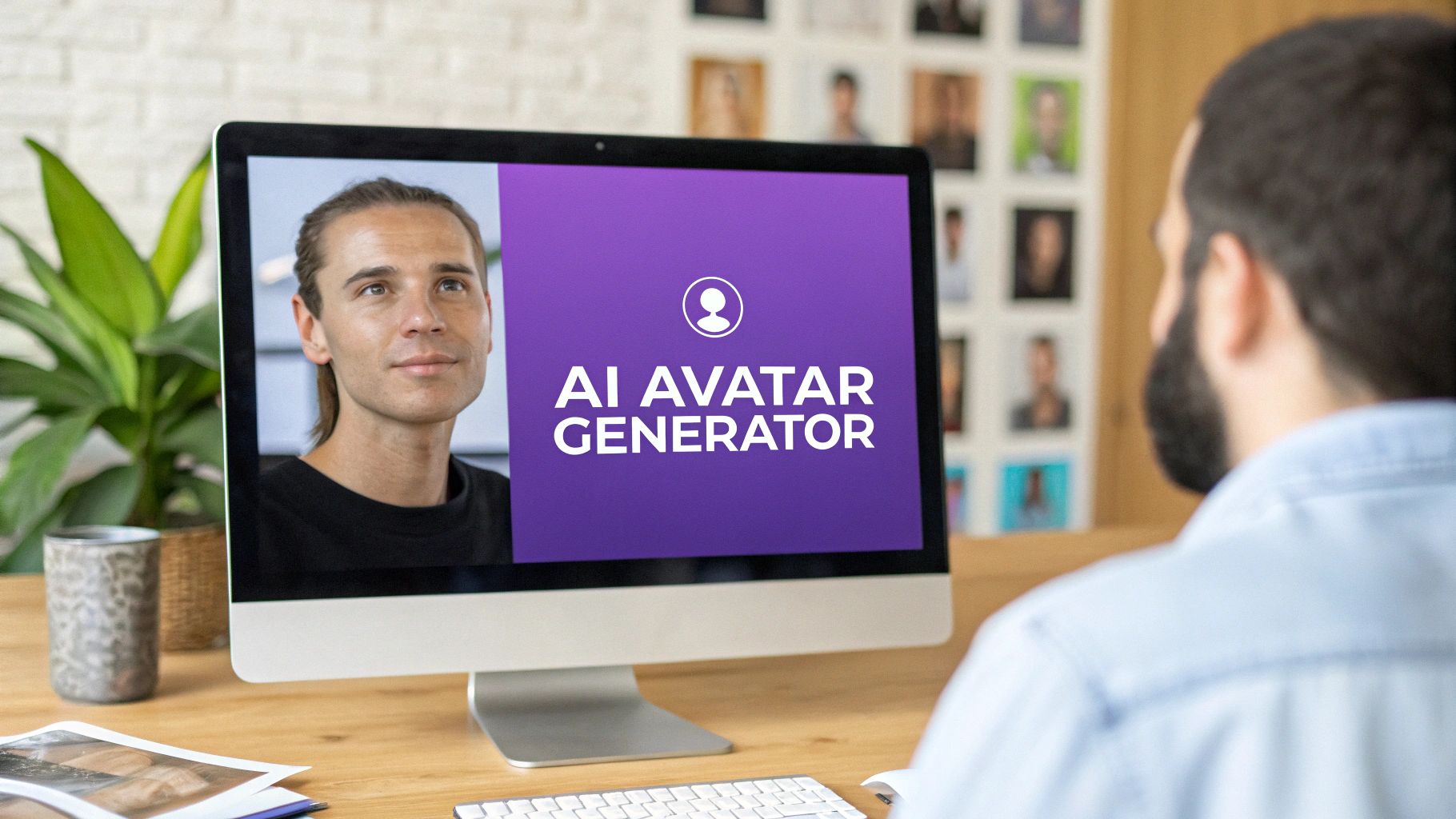A Modern Social Media Branding Guide

This guide is your complete blueprint for building a social media presence that’s memorable, consistent, and genuinely you. We’ll break down how to define your brand’s voice, pick the right platforms, and create content that turns casual followers into loyal fans—making sure every single post reinforces who you are.
Why Social Media Branding Is Your Digital Handshake

Think of your social media presence as your brand's digital handshake. It’s often the very first impression you make, the initial conversation starter, and the bedrock of what could become a lasting customer relationship. Social media branding is the deliberate, ongoing process of shaping your brand's story, personality, and visual identity across every channel you use.
But it’s so much more than just posting updates. It's about creating a unified experience that tells your audience exactly who you are, what you stand for, and why they should care. When you get it right, every tweet, story, and comment works together to build a powerful sense of familiarity and trust.
The Power of a Cohesive Presence
In today's crowded digital world, consistency is what makes a brand stick. Your audience should be able to recognize your content in a split second, whether they’re scrolling through Instagram, LinkedIn, or X. This instant recognition is built on a few core pillars.
To help you get a quick handle on this, the table below breaks down the essential pillars of social media branding. Think of it as your quick-reference guide to the key elements we'll be exploring.
The Pillars of a Memorable Social Brand
| Pillar | What It Means in Practice | Primary Goal |
|---|---|---|
| Consistent Voice & Tone | Deciding if you're a witty friend, a trusted expert, or an inspiring mentor—and sticking to it. | Build a relatable personality that your audience connects with. |
| Unified Visual Identity | Using the same logo, color palette, fonts, and image style across all platforms. | Create instant brand recognition in a busy social media feed. |
| Clear Value Proposition | Ensuring every piece of content subtly reinforces the core value you offer to customers. | Remind your audience why they should choose you over anyone else. |
This consistency creates a powerful sense of reliability and professionalism. A solid social media strategy plan is the foundation that holds all of this together, ensuring every branding effort is intentional and effective.
Social media branding isn't just another marketing task; it's a core business function that shapes how customers see, remember, and ultimately choose your brand over competitors.
Why It Matters More Than Ever
Let's be real: social platforms are often the very first place people discover new brands. Recent analysis shows that social media's role in brand discovery continues to climb, now accounting for 29.7% of how adult internet users find new products and services.
This number alone highlights why social media is a critical first touchpoint. This guide will give you the framework to make that first impression not just good, but unforgettable.
Find Your Brand’s Soul Before You Post Anything
Before you even think about writing a single post, you need to know who you are. Seriously. Think of your social media presence as a character in a story. If that character is all over the place—sometimes funny, sometimes serious, sometimes formal—the audience gets confused and tunes out. Your brand is no different.
The very first step is to look inward. You need to translate your company’s core mission and values into a distinct social media personality. This is about deciding who you want to be in your audience's feed every single day. This is the foundation. Every post, story, and comment you publish will build on it, making sure everything feels authentic and consistently you.
Find Your Brand Archetype
A fantastic way to nail down your brand’s personality is by using brand archetypes. These are basically universal character types that help you define your brand’s core identity. Is your brand…
- The Sage? You’re the trusted expert, the one people turn to for wisdom and clarity (think Google or Mayo Clinic).
- The Jester? You’re the witty, fun-loving friend who brings a little joy to the everyday (like Old Spice or M&M's).
- The Hero? You’re a champion, inspiring courage and helping people overcome big challenges (think Nike or FedEx).
- The Caregiver? You’re a nurturing presence, offering compassion and support when it’s needed most (like Johnson & Johnson or TOMS).
Picking an archetype gives you a compass for your tone of voice. A Sage will communicate with authority and data. A Jester will lean into humor and pop culture. This simple choice will guide everything from the words you use in your captions to the emojis you pick.
A brand's personality is its emotional and human core. It’s not about what you sell, but how you make people feel. Authenticity is everything—in fact, 88% of consumers say it’s a key factor when deciding which brands to support.
Once you’ve got a personality, you can build a voice that brings it to life. Get specific. Document the words you will use and, just as importantly, the words you won't. A formal "Sage" brand would probably steer clear of slang, while a playful "Jester" brand would embrace it.
Craft Your Visual Identity
With your brand's personality set, it’s time to give it a face. This is your brand's visual signature—the "look and feel" that makes your content instantly recognizable in a crowded, fast-scrolling feed. You simply can't build a strong brand on social media without a solid visual identity.
This is about so much more than just a logo. It’s a complete visual system where every element works together to create a cohesive experience. Think of your visual brand kit as the North Star for all your content creation.
Key Components of a Visual Brand Kit:
- Color Palette: Pick a primary, secondary, and accent color. Make sure these colors evoke the feelings tied to your brand archetype.
- Typography: Choose one or two consistent, readable fonts that feel on-brand for headlines and body text.
- Logo Usage: Set clear rules for how your logo should appear—think minimum sizes, clear space, and variations for light or dark backgrounds.
- Imagery Style: Define the vibe of your photos and graphics. Are they bright and airy? Dark and moody? Polished and professional? Or candid and real?
This visual consistency is what stops the scroll. It builds familiarity and trust, signaling to your audience that they’ve landed in the right place. Remember, you’re in a constant battle for attention. With over 5.4 billion social media users worldwide as of early 2025—each one juggling nearly seven different platforms a month—a distinct visual identity is your best weapon. Want to dig deeper? Check out the latest social media statistics to see what you're up against.
Choosing Social Platforms Where Your Brand Belongs
Let’s be honest: trying to be on every single social media platform is a recipe for burnout. It’s a common mistake that stretches your resources thin and delivers mediocre results. A much smarter approach? Be strategic. Focus your energy on the platforms where your brand can genuinely connect and shine.
This isn’t about chasing the platform with the most users. It’s about understanding the unique culture of each space and finding where your ideal audience actually wants to hear from you.
Think of it this way: each social platform is like a different party. A post that would get a round of applause at a professional conference (LinkedIn) is going to fall completely flat at a casual backyard barbecue (TikTok). To build a strong brand on social media, you have to show up to the right party, dressed for the occasion. That means aligning your brand’s personality with what users on that platform expect.
Match Your Brand to the Platform Culture
Every social network has its own vibe—its own unwritten rules, content styles, and user habits. A huge part of building a social media brand is learning to read the room. Don't try to jam a square peg into a round hole by copy-pasting the same content everywhere. Instead, get a feel for the core purpose of each platform.
Here’s a quick rundown of the "vibe" on the major players:
- LinkedIn: This is the spot for professional authority and B2B connections. It’s perfect for sharing industry insights, company news, and thought leadership. The tone here is professional, informative, and aspirational.
- Instagram: A visual-first world built for storytelling through stunning images and videos. It’s where lifestyle brands are born, products are showcased beautifully, and connections are made through aesthetics.
- TikTok: The capital of authentic, short-form video entertainment. Success here is all about creativity, humor, and jumping on trends. Brands that win are human, relatable, and not afraid to be a little unpolished.
- Facebook: A super versatile platform designed for community building. It’s great for reaching a broad demographic, sharing all kinds of content (from links to videos), and sparking conversations in groups.
Choosing your platforms isn't about a popularity contest. It's about strategic alignment. Your goal is to find that sweet spot where your target audience hangs out and your brand's natural voice fits right into the conversation.
This infographic breaks down the core brand elements you'll need to adapt for each social media environment.

As the image shows, your foundational brand elements—like your color palette and logo—need to be consistent, but also flexible enough to work in different social settings.
To help you make a more informed choice, here’s a breakdown of the major platforms.
A Strategic Guide to Choosing Your Platforms
This table compares the major social media platforms to help you decide where to invest your time and resources based on your audience and content goals.
| Platform | Primary Audience Demographics | Best for This Content | Recommended Brand Voice |
|---|---|---|---|
| Professionals, B2B decision-makers, job seekers (Ages 25-49) | Industry insights, company culture, long-form articles, career advice | Professional, Authoritative, Educational | |
| Millennials & Gen Z (Ages 18-34), visually-driven consumers | High-quality photos, Reels, Stories, influencer collaborations | Aspirational, Creative, Stylish, Personable | |
| TikTok | Gen Z & young Millennials (Ages 16-24), trend-followers | Short-form videos, tutorials, behind-the-scenes, user-generated content | Authentic, Humorous, Relatable, Entertaining |
| Broad, diverse demographic, strong in Gen X & Boomers (Ages 25-55+) | Community updates, news, video, events, customer service | Friendly, Helpful, Community-Oriented, Informative |
Use this guide as a starting point. The best choice is always the one that puts your brand in the best position to connect with the people who matter most.
Analyze Your Audience and Resources
Once you’ve got a handle on the platform cultures, it’s time to look inward at your audience and your own capabilities. You can’t make a good decision without data. Answering these questions will give you the clarity you need to focus your efforts where they’ll have the biggest impact.
Questions to Ask About Your Audience:
- Where do they hang out? Use surveys, customer feedback, and your website analytics to figure out which platforms your ideal customers are actually using.
- What’s their intent? Think about why they use a specific platform. Are they scrolling Instagram for inspiration, browsing LinkedIn for career growth, or killing time on TikTok for a quick laugh?
- How do they engage? Pay attention to the types of content they like, comment on, and share. This is a goldmine of information about what they find valuable.
After you’ve sized up your audience, do an honest check of your own resources. Do you have a skilled videographer on hand for a TikTok-heavy strategy? Do you have strong writers who can craft compelling long-form articles for LinkedIn? Your available time, budget, and in-house skills will ultimately decide which platforms you can realistically support with high-quality content.
It’s far better to be a star on two relevant platforms than to be just okay on five. This focused approach is what separates the brands that struggle from the ones that succeed, ensuring every bit of your effort delivers real engagement and a solid return on your investment.
Building a Content Strategy That Connects

Great content is the engine that drives your brand's story on social media. Without a clear plan, you're essentially just shouting into the void. A solid content strategy is what turns random posts into a cohesive narrative that actually connects with your audience, building trust and a real community along the way.
This isn't about just plugging holes in a calendar; it's about being intentional with every post. The goal is to deliver genuine value—making your audience feel seen, understood, and appreciated. That means focusing on content that educates, entertains, or inspires them long before you ever ask for a sale.
Introducing the Content Pillar Model
One of the most effective frameworks for brainstorming ideas is the content pillar model. Think of content pillars as the 3-5 core themes or topics your brand will own and talk about consistently. These pillars should flow directly from your brand identity, your audience’s passions, and your business goals.
They act as a creative guardrail, ensuring everything you publish is relevant and on-brand.
For example, a fitness app's content pillars might look like this:
- Workout Tutorials: Showing off exercises and full routines.
- Nutrition Tips: Sharing healthy recipes and meal prep hacks.
- Mindset & Motivation: Posting inspirational stories and mental wellness advice.
- Community Spotlights: Featuring user success stories and transformations.
This approach stops the daily scramble for ideas. Instead, you have a reliable well of topics to draw from, making your content creation process far more streamlined and consistent. It’s a fundamental step in building a brand people look to for specific kinds of value.
A value-first approach isn't just good karma; it's smart marketing. When you consistently solve problems, answer questions, or bring a little joy to your audience's feed, you earn their attention and trust. Sales become a natural byproduct of the relationship you’ve built.
Diversifying Your Content Formats
Once your pillars are locked in, it's time to think about how you’ll bring those ideas to life. Relying on a single content format is like a musician who only knows one chord—it gets repetitive, fast. To keep your audience hooked, you need to mix and match different formats.
Think about how each format serves a unique purpose:
- Compelling Video: Use short-form video (Reels, TikToks) for quick tips, behind-the-scenes content, and fun trends. Save longer videos for in-depth tutorials or interviews.
- Insightful Carousels: These multi-slide posts are perfect for breaking down complex topics into bite-sized, digestible steps. Think of them as mini-guides or visual stories.
- Interactive Stories: Leverage polls, quizzes, and Q&A stickers to spark direct conversations and gather real-time feedback from your community.
- User-Generated Content (UGC): Encourage your followers to share photos or videos featuring your product. Resharing UGC is powerful social proof that builds both community and credibility.
Create a Consistent Content Calendar
All these brilliant ideas need a home. A content calendar is your roadmap, turning your high-level strategy into a manageable, day-to-day plan. This simple tool helps you visualize your posting schedule and maintain a steady flow of quality content.
To make sure your brand's voice stays consistent and impactful across all channels, mastering effective content planning for social media is an absolute must.
Your calendar doesn’t have to be some overly complicated software. A simple spreadsheet tracking the date, platform, content pillar, format, and caption is often all you need to get started. The real key is consistency. By planning ahead, you eliminate last-minute panic and maintain the high-quality presence your brand deserves.
Turning Followers Into Brand Advocates
Think of your social media presence less like a stage for a monologue and more like a lively dinner party. The real magic isn't in broadcasting your message louder; it's in pulling up a chair and starting a real conversation. This is the secret to turning a list of followers into a loyal community that genuinely roots for your brand.
This kind of transformation doesn’t just happen. It’s built on a foundation of consistent, authentic engagement—the art of turning passive scrollers into people who actually want to join in. It means replying to comments (the good and the bad), sparking interesting discussions, and making the people in your audience feel seen.
From Engagement to Community
Real engagement is so much more than just a quick "like" on a comment. It’s about making your audience feel heard, valued, and like they’re part of something bigger. When someone leaves a comment, they're opening a door. It's your job to walk through it.
Beyond just gaining followers, the true test of a strong social brand is knowing how to increase social media engagement. This isn't just about getting people to consume your content; it's about inviting them to help create the experience alongside you.
Here are a few practical ways to get the ball rolling:
- Host Live Q&A Sessions: Jump on Instagram Live or LinkedIn to answer questions in real time. There's nothing like unfiltered, direct interaction to build trust and show the human side of your brand.
- Run Interactive Polls and Quizzes: Use your Stories to ask for opinions, test people's knowledge, or just have a bit of fun. It’s a low-effort way for followers to participate and gives you a peek into what they actually think.
- Spark "Fill-in-the-Blank" Posts: Ask easy, open-ended questions like, "My go-to productivity hack is ______." These are simple to answer and often generate a ton of responses and conversation.
The goal is to foster a vibrant community that doesn't just watch, but actively participates. Every interaction is a deposit into the bank of brand loyalty, building an asset that competitors can't easily replicate.
Celebrating Your Biggest Fans: User-Generated Content
One of the most powerful tools you have for building a community is user-generated content (UGC). Simply put, this is any content—photos, videos, reviews, or testimonials—created by your customers instead of by you. When you share UGC, you accomplish two things at once: you celebrate your customers and you provide incredible social proof.
Think of it as the ultimate seal of approval. It’s one thing for you to say your product is great, but it’s far more convincing when your happy customers are saying it for you. This kind of authentic praise beats a polished ad campaign any day.
Here's how to encourage more UGC:
- Create a branded hashtag and ask customers to use it when they post about your product.
- Run contests or giveaways where submitting a photo or video is part of the entry.
- Regularly feature your favorite customer posts on your feed or in your Stories (just be sure to ask for permission and give proper credit!).
This strategy gives you a constant flow of genuine content and makes your customers feel like they’re true partners in your brand's story. It's a win-win that builds deep relationships and a powerful sense of belonging.
The ROI of a Strong Community
Investing in your community isn’t just a feel-good tactic; it drives real business results. Global social media ad spending is on track to hit nearly $277 billion by 2025, so brands are understandably focused on getting the most out of every dollar. While paid ads have their place, an engaged community acts as a massive amplifier.
In fact, teams that use social listening tools to tap into their community's pulse are almost twice as confident in their social media ROI. A loyal community effectively becomes your best marketing channel, turning followers into advocates who recommend your brand to others—enthusiastically and for free.
Measuring What Matters and Refining Your Approach
A guide to social media branding wouldn't be complete without talking about how to actually track your progress. Let's be honest: you can't grow what you don't measure. In the world of social media, data is your compass—it steers you away from guesswork and points you toward strategies that deliver real results.
It’s easy to get lost in flashy numbers, but the real goal is to zero in on the metrics that directly link to your business objectives.
This means looking right past vanity metrics. A massive follower count might feel great, but it doesn't pay the bills. Real success lies in the data that shows you how your audience is actually interacting with your brand and what that interaction is doing for your bottom line.
Think of it as creating a powerful feedback loop. You analyze the data, pull out the insights, and then use those insights to tweak and improve your strategy. This cycle is what fuels sustainable, long-term growth.
Focusing on Metrics That Matter
To get a true read on your social media branding, you have to shift from surface-level numbers to data that shows genuine engagement and impact. These are the metrics that tell you if your branding is truly connecting with people.
Here are the key performance indicators (KPIs) you should have on your dashboard:
- Engagement Rate: This is your brand's pulse. It measures the percentage of your audience that interacts with your content through likes, comments, shares, and saves. A high engagement rate is a strong signal that your brand voice and content are hitting the mark.
- Reach and Impressions: Reach tells you the total number of unique people who saw your content, while impressions count the total number of times it was displayed. Tracking reach helps you see how far your message is spreading beyond your immediate followers.
- Website Click-Through Rate (CTR): This one is straightforward—it measures how many people saw your post and clicked the link to your website. A healthy CTR shows your calls-to-action are compelling and your content is successfully moving people where you want them to go.
- Conversion Rate: This is the ultimate bottom-line metric. It tracks how many people take a specific, desired action after clicking through, like signing up for a newsletter, downloading a guide, or making a purchase.
Using A/B Testing to Continuously Improve
Once you're tracking the right data, you can start actively improving your results through experimentation. A/B testing, or split testing, is a simple but incredibly powerful way to optimize your content. It’s all about creating two slightly different versions of a post to see which one performs better.
Think of A/B testing as a scientific approach to creativity. Instead of guessing what works best, you let your audience's behavior give you the answer, ensuring every decision is backed by data.
You can A/B test just about any element of your social posts to discover what truly resonates with your audience.
Simple A/B Tests to Run:
- Headlines and Captions: Try a direct, benefit-driven caption against one that asks a question or uses a storytelling angle.
- Visuals: Post the same caption but use a different image or video. For example, test a polished graphic against a more candid, behind-the-scenes photo.
- Calls-to-Action (CTAs): Compare a hard CTA like "Shop Now" with a softer one like "Learn More" to see which drives more clicks for a particular offer.
By consistently analyzing your data and running small, smart tests, you turn your social media strategy from a static plan into a living, breathing system that gets smarter with every single post.
Got Questions About Social Media Branding?
As you start putting your branding strategy into action, a few questions always seem to pop up. Let's tackle some of the most common ones with practical answers to keep you on the right track.
How Do I Keep My Brand Consistent Across All Platforms?
This is a big one. Consistency isn't about being a robot—it’s about having a flexible brand kit that adapts to each platform's vibe. Your core mission, logo, and main colors should stay the same, but your tone of voice and content style need to shift.
Think of it this way: your brand is a person. You wouldn't wear a tuxedo to a backyard barbecue, right? In the same way, the authoritative, professional voice you use on LinkedIn can (and should) become more casual and even humorous on TikTok. The goal is a unified brand experience, not a copy-paste one.
What’s the Best Way to Handle Negative Feedback?
Sooner or later, a negative comment will appear. It’s just part of the game. The key is to respond promptly, publicly, and professionally. Whatever you do, don't delete the feedback unless it’s clear spam or uses offensive language.
Acknowledge their frustration, thank them for bringing it to your attention, and offer to move the conversation to a private channel like DMs or email to sort it out. This shows everyone watching that you’re transparent and genuinely care about getting things right. It can even turn a bad situation into a moment that builds serious trust.
Your response to criticism defines your brand's character more than your promotional posts ever will. Handle it with grace to build trust.
How Can I Actually Prove the ROI of Branding Efforts?
Measuring the return on investment (ROI) for branding means looking past vanity metrics like follower counts. You need to connect your social media activity to real business goals.
Focus on the data that tells a story:
- Track Engagement Rate: This shows if your content is actually hitting the mark with your audience.
- Monitor Website Clicks: Are your social posts successfully driving people back to your site?
- Measure Conversion Rates: How many people who come from social media end up buying something, signing up, or taking another key action?
By tying your social performance to these tangible results, you can clearly show the value your branding strategy is bringing to the table.
Ready to stop guessing and start building a powerful, professional online presence? MakerBox uses AI to instantly generate optimized bios, profile pictures, and content that gets you noticed. Transform your professional brand in 30 seconds at MakerBox.





